How to Operate: Snow Joe Cordless Snow Blower iON18SB Manual
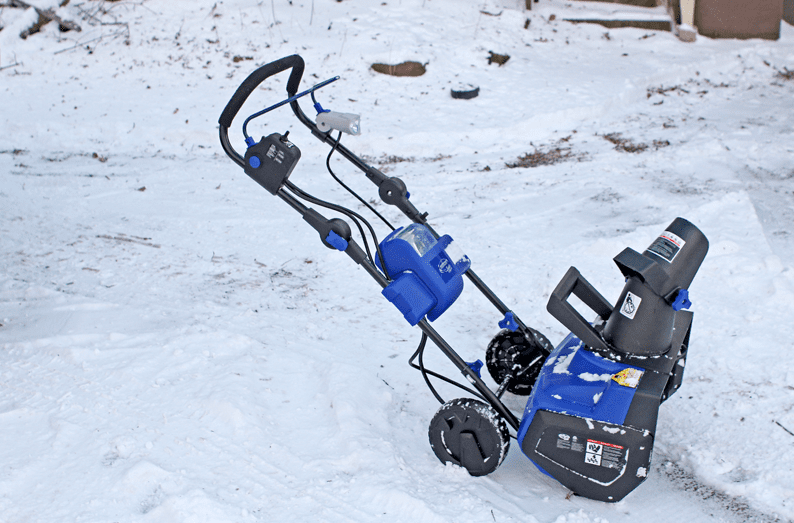
Content
Introduction of Snow Joe Cordless Snow Blower iON18SB
The Snow Joe Cordless Snow Blower iON18SB is a revolutionary tool for tackling snowy walkways and driveways. This powerful and eco-friendly snow blower is cordless, making it easy to maneuver and operate. With an estimated price range of $250 to $300 and a launching date in late 2021, this product is a must-have for the upcoming winter season.
Detailed Specifications
The Snow Joe Cordless Snow Blower iON18SB boasts the following key features:
- 40V iON MAX rechargeable battery system
- 18-inch clearing width and 8-inch intake height
- 400 lbs. of snow per minute moving capacity
- LED headlight for better visibility in low light conditions
- Compact and lightweight design (only 32 lbs.)
- Easy-adjust chute control for directing snow up to 20 feet away
- Rubber-tipped steel augers for durability and safety
- Two-blade auger for efficient snow clearing
- Rechargeable 4.0 Ah battery with a weather-resistant design
- Quick-start button for easy ignition
Snow Joe Accessories
WARNING! ALWAYS use only authorized Snow Joe® + Sun Joe® replacement parts and accessories. NEVER use replacement parts or accessories that are not intended for use with this cordless snow blower. Contact Snow Joe® + Sun Joe® if you are unsure whether it is safe to use a particular replacement part or accessory with your cordless snow blower. The use of any other attachment or accessory can be dangerous and could cause injury or mechanical damage.
Accessories |
Item |
Model |
 |
iONMAX 40 V 4.0 Ah Lithium-Ion Battery Battery ChargeTime Max: iCHRG40: 3 hours iCHRG40-DPC: 3.5 hours Battery Run Time Max: 50 min |
iBAT40 |
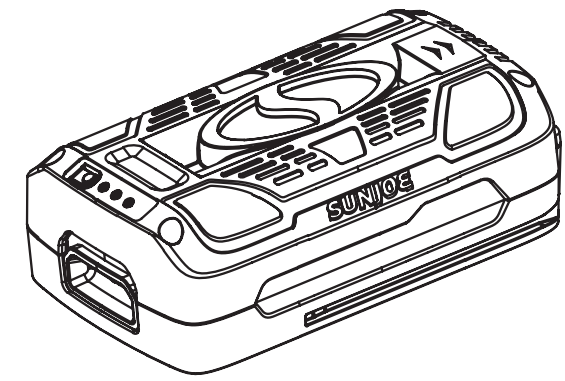 |
iONMAX 40 V 5.0 Ah PRO SERIES Lithium-Ion Battery Battery ChargeTime Max: iCHRG40: 3.5 hours iCHRG40-DPC: 4 hours Battery Run Time Max: 65 min |
iBAT40XR |
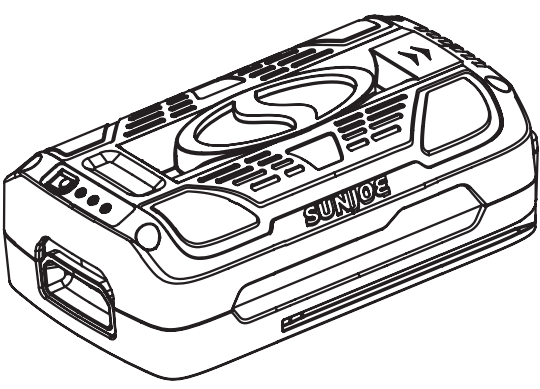 |
iONMAX 40 V 6.0 Ah PRO SERIESLithium-Ion Battery Battery ChargeTime Max: iCHRG40: 5 hours iCHRG40-DPC: 5.5 hours Battery Run Time Max: 75 min |
iBAT40XRP |
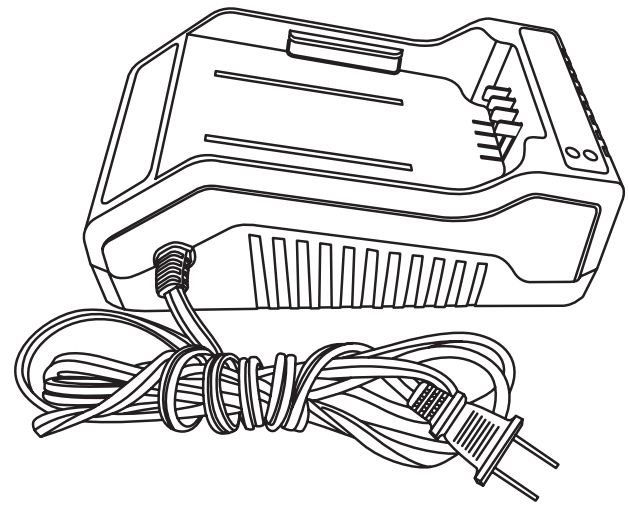 |
iON MAX 40 V Lithium-Ion Battery Charger |
iCHRG40 |
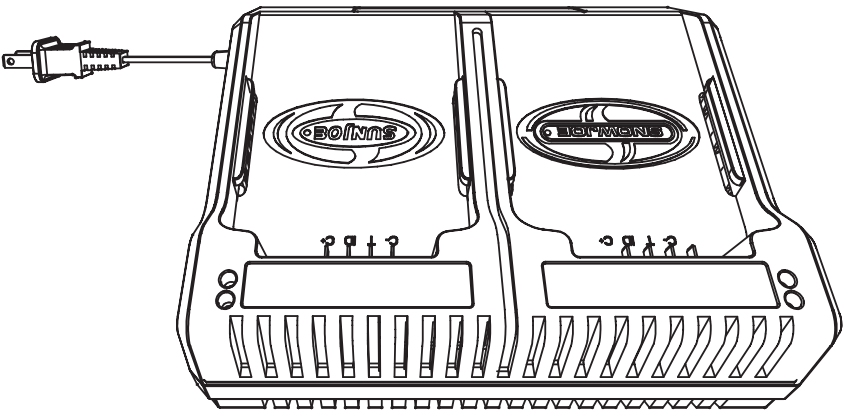 |
iON MAX 40 V Lithium-Ion Dual Port Battery Charger |
iCHRG40-DPC |
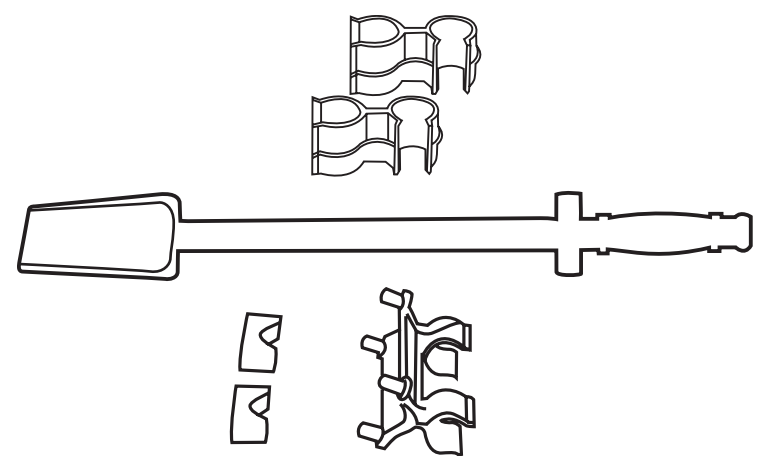 |
Universal Snow Thrower Chute Clean-Out Tool |
SJCOT |
Safety Instructions
All Operators Must Read These Instructions Before Use. Read all instructions when using cordless snow blowers. Basic safety precautions should always be followed to reduce the risk of fire, electric shock, and personal injury.
General Safety Rules
Notice the personal safety alert symbol m used in this manual to draw your attention to a WARNING given along with the particular operating instruction. This means that the operation requires special ATTENTION, CAUTION, and AWARENESS.
- Keep work area clean and well lit
Cluttered, dark areas invite accidents. - Keep bystanders away
All bystanders and pets should be kept a safe distance away from the work area. - Dress properly
Do not wear loose clothing or jewelry. They can get caught in moving parts. Protective rubber gloves and non-slip footwear are recommended when working outdoors. - Use the right product
Do not use this machine for any job except that for which it is intended. - CAUTION! Exercise caution to avoid slipping or falling. Wear protective footwear that will protect your feet and improve your footing on slippery surfaces.
- Use safety glasses
Also use safety footwear, snug-fitting clothing, protective gloves, hearing and head protection. - Do not force the snow blower
Use the snow blower at the rate for which it was designed to ensure optimal performance and safe operation. - Stay alert
Watch what you are doing. Use common sense. Do not operate the snow blower when you are tired or under the influence of alcohol or drugs. - Do not overreach
Keep proper footing and balance at all times. - Store indoors
When not in use, the snow blower should be kept dry and stored out of the reach of children in a high or locked place. - Maintain snow blower with care
Follow instructions for lubricating and changing accessories. - WARNING! Turn off the power switch and disconnect the battery before making any adjustments, inspecting, servicing, changing accessories, cleaning the snow blower, or when any other dangerous conditions present. Any
such operation should be performed after revolving parts inside the snow blower stop completely. Such preventive safety measures reduce the risk of starting the power tool accidentally. - WARNING! When replacing any parts, you must strictly observe the instructions and procedures described in this user manual. Special care should be paid to any rubber parts, since these parts may increase the engine load and decrease its mechanical power if damaged.
- WARNING! If you notice that the snow blower is not running properly or hear abnormal sounds from the engine when it is in use, immediately stop the machine, disconnect the battery, and contact your service center.
- Surfaces
This snow blower is intended for use on paved surfaces. Do not use on gravel, stone or other unpaved surfaces unless the snow blower is adjusted for such surfaces according to the instructions given in the operator’s manual. - Moving parts present risks
Keep your face, hair, clothing, hands, and feet away from moving parts. All guards and safety attachments must be installed properly before using the unit. Shut off and disconnect the battery before touching any parts other than the handles and switch. - Avoid unintentional starting
Make sure the safety switch and the switch bar lever are in the off position before inserting the battery in the unit. Do not carry the snow blower with the safety switch and the switch bar lever engaged. - Do not overreach
Maintain proper footing and balance at all times. Place heels firmly on the ground and tightly grasp the handle bar. Watch for uneven surfaces and do not overreach. In case you fall or collide with the snow blower, inspect the unit for any damages or cracks. When stepping backwards, be careful to avoid obstacles beneath your feet or behind you to avoid falling.
WARNING! If the snow blower strikes any object, follow these steps:
- Stop the snow blower.
- Remove the battery. Inspect for damage.
- Repair any damage before restarting and operating the snow blower.
Battery + Charger of Snow Joe Cordless Snow Blower iON18SB
We pay a great deal of attention to the design of every battery pack to ensure that we supply you with batteries that are safe, durable and have a high energy density. The battery cells have a wide range of safety devices. Each individual cell is initially formatted and its electrical characteristic curves are recorded. This data is then used exclusively to be able to assemble the best possible battery packs. Despite all the safety precautions, caution must always be exercised when handling batteries. The following points must be obeyed at all times to ensure safe use. Safe use can only be guaranteed if undamaged cells are used. Incorrect handling of the battery pack can cause cell damage.
IMPORTANT! Analyses confirm that incorrect use and poor care of high-performance batteries are the main factors responsible for personal and/or product damage.
WARNING! Use only approved replacement batteries; other batteries may damage the cordless snow blower and cause it to malfunction, which can lead to serious personal injury.
CAUTION! To reduce the risk of injury, charge the iON MAX iBAT40 lithium-ion battery pack only in its designated lithium-ion charger, the iCHRG40. Other types of chargers present risk of fire, personal injury and damage. Do not wire a battery pack to a power supply plug or car cigarette lighter. Such misuse will permanently disable or damage the battery pack.
- Avoid dangerous environments
Do not charge the battery pack in rain, snow or in damp or wet locations. Do not use the battery pack or charger in the presence of explosive atmospheres (gaseous fumes, dust or flammable materials) because sparks may be generated when inserting or removing the battery pack, which could lead to a fire. - Charge in a well-ventilated area
Do not block the charger vents. Keep them clear to allow for proper ventilation. Do not allow smoking or open flames near a charging battery pack. Vented gases may explode.
NOTE: The safe temperature range for the battery is -4°F (-20°C) to 113°F (45°C). Do not charge the battery outside in freezing weather; charge it at room temperature. - Maintain charger cord
When unplugging the charger, pull the plug, not the cord, from the receptacle to reduce the risk of damage to the electrical plug and cord. Never carry the charger by its cord or yank it by the cord to disconnect it from the receptacle. Keep the cord away from heat, oil and sharp edges. Make sure the cord will not be stepped on, tripped over or subjected to damage or stress when the charger is in use. Do not use the charger with a damaged cord or plug. Replace a damaged charger immediately. - Do not use an extension cord unless it is absolutely necessary
Using the wrong, damaged or improperly wired extension cord poses a risk of fire and electric shock. If an extension cord must be used, plug the charger into a properly wired 16 gauge or larger extension cord with the female plug matching the male plug on the charger. Make sure that the extension cord is in good electrical condition. - Charger iCHRG40 is rated for 120 volt AC only
The charger must be plugged into an appropriate receptacle. - Use only recommended attachments
Use of an attachment not recommended or sold by the battery charger or battery pack manufacturer may result in risk of fire, electric shock or personal injury. - Unplug charger when not in use
Make sure to remove battery packs from unplugged chargers. - WARNING! To reduce the risk of electric shock, always unplug the charger before performing any cleaning or maintenance. Do not allow water to flow into the charger. Use a Ground Fault Circuit Interrupter (GFCI) to reduce shock hazards.
- Do not burn or incinerate battery packs
- Battery packs may explode, causing personal injury or damage. Toxic fumes and materials are created when battery packs are burned.
- Do not crush, drop or damage battery packs
- Do not use the battery pack or charger if they have sustained a sharp blow, been dropped, run over or have been damaged in any way (i.e. pierced with a nail, hit with a hammer, stepped on, etc.).
- Do not disassemble Incorrect reassembly may pose a serious risk of electric shock, fire or exposure to toxic battery chemicals.
- Battery chemicals cause serious burns
Never let a damaged battery pack contact the skin, eyes or mouth. If a damaged battery pack leaks battery chemicals, use rubber or neoprene gloves to safely dispose of it. If skin is exposed to battery fluids, wash the affected area with soap and water and rinse with vinegar. If eyes are exposed to battery chemicals, immediately flush with water for 20 minutes and seek medical attention. Remove and dispose of contaminated clothing. - Do not short circuit
A battery pack will short circuit if a metal object makes a connection between the positive and negative contacts on the battery pack. Do not place a battery pack near anything that may cause a short circuit, such as paper clips, coins, keys, screws, nails and other metallic objects. A short-circuited battery pack poses a risk of fire and severe personal injury. - Store your battery pack and charger in a cool, dry place
Do not store the battery pack or charger where temperatures may exceed 104ºF (40ºC), such as in direct sunlight or inside a vehicle or metal building during the summer.
Information about the battery
- The battery pack supplied with your cordless snow blower is only partially charged. The battery pack has to be charged completely before you use the tool for the first time.
- For optimum battery performance, avoid low discharge cycles by charging the battery pack frequently.
- Store the battery pack in a cool place, ideally at 59°F (15°C) and charged to at least 40%.
- Lithium-ion batteries are subject to a natural aging process. The battery pack must be replaced at the latest when its capacity falls to just 80% of its capacity when new. Weakened cells in an aged battery pack are no longer capable of meeting the high power requirements needed for the proper operation of your snow blower, and therefore pose a safety risk.
- Do not throw battery packs into an open fire as this poses a risk of explosion.
- Do not ignite the battery pack or expose it to fire.
- Do not exhaustively discharge batteries. Exhaustive discharge will damage the battery cells. The most common cause of exhaustive discharge is lengthy storage or non-use of partially discharged batteries. Stop working as soon as the performance of the battery falls noticeably or the electronic protection system triggers. Place the battery pack in storage only after it has been fully charged.
- Protect batteries and the tool from overloads. Overloads will quickly result in overheating and cell damage inside the battery housing even if this overheating is not apparent externally.
- Avoid damage and shocks. Immediately replace batteries that have been dropped from a height of more than one meter or those that have been exposed to violent shocks, even if the housing of the battery pack appears to be undamaged. The battery cells inside the battery may have suffered serious damage. In such instances, please read the waste disposal information for proper battery disposal.
- If the battery pack suffers overloading and overheating, the integrated protective cutoff will switch off the equipment for safety reasons.
IMPORTANT! Do not press the ON/OFF switch any more if the protective cut-off has been activated. This may damage the battery pack. Use only original battery packs. The use of other batteries poses a fire risk and may result in injuries or an explosion.
Information about the charger and the charging process
- Please check the data marked on the rating plate of the battery charger. Be sure to connect the battery charger to a power supply with the voltage marked on the rating plate. Never connect it to a different mains voltage.
- Protect the battery charger and its cord from damage. Keep the charger and its cord away from heat, oil and sharp edges.
- Electrical plugs must match the outlet. Never modify the plug in any way. Do not use any adapter plugs with grounded appliances. Unmodified plugs and matching outlets will reduce the risk of electric shock.
- Keep the battery charger, battery pack(s) and the cordless tool out of the reach of children.
- Do not use the supplied battery charger to charge other cordless tools.
- During periods of heavy use, the battery pack will become warm. Allow the battery pack to cool to room temperature before inserting it into the charger to recharge.
- Do not overcharge batteries. Do not exceed the maximum charging times. These charging times only apply to discharged batteries. Frequent insertion of a charged or partially charged battery pack will result in overcharging and cell damage. Do not leave batteries in the charger for days on end.
- Never use or charge batteries if you suspect that it has been more than 12 months since the last time they were charged. There is a high probability that the battery pack has already suffered dangerous damage (exhaustive discharge).
- Charging batteries at a temperature below 50°F (10°C) will cause chemical damage to the cells and may cause a fire.
- Do not use batteries that have been exposed to heat during the charging process, as the battery cells may have suffered dangerous damage.
- Do not use batteries that have suffered curvature or deformation during the charging process or those that exhibit other atypical symptoms (gassing, hissing, cracking, etc.)
- Never fully discharge the battery pack (maximum recommended depth of discharge is 80%). A complete discharge of the battery pack will lead to premature aging of the battery cells.
Protection from environmental influences
- Wear suitable work clothes. Wear safety goggles.
- Protect your cordless tool and the battery charger from moisture and rain. Moisture and rain can cause dangerous cell damage.
- Do not use the cordless tool or the battery charger near vapors and flammable liquids.
- Use the battery charger and cordless tools only in dry conditions and at an ambient temperature of 50-104°F (10-40°C).
- Do not keep the battery charger in places where the temperature is liable to reach over 104°F (40°C). In particular, do not leave the battery charger in a car that is parked in the sunshine.
- Protect batteries from overheating. Overloads, overcharging and exposure to direct sunlight will result in overheating and cell damage. Never charge or work with batteries that have been overheated – replace them immediately, if possible.
- Store the charger and your cordless tool only in dry locations with an ambient temperature of 50-104°F (10-40°C). Store your lithium-ion battery pack in a cool, dry place at a temperature of 50-68°F (10-20°C). Protect the battery pack, charger and cordless tool from humidity and direct sunlight. Only place fully charged batteries in storage (charged to at least 40%).
- Prevent the lithium-ion battery pack from freezing. Battery packs that were stored below 32°F (0°C) for more than 60 minutes must be discarded.
- When handling batteries, be wary of electrostatic charge. Electrostatic discharges can damage the electronic protection system and the battery cells. Avoid electrostatic charging and never touch the battery poles.
Additional Safety Instructions
Safety Instructions for Walk-Behind Snow Blowers
- Read the operator’s manual carefully
Learn your snow blower’s applications and limitations as well as the specific potential hazards related to this machine. Do not use this machine for any purpose other than the one for which it was designed. Failure to adhere to these precautions may cause mechanical defaults, serious damage, or personal injury. - Preliminary unit inspection
Thoroughly inspect the unit before use. Make sure all the parts are secure and installed correctly. If you notice any abnormalities, do not use the machine until it has been properly repaired. Always perform a test run the first time you use the snow blower or after replacing parts to ensure that the unit is functioning properly. - Preliminary area inspection
Clear the area to be plowed before each use. Remove all objects such as rocks, broken glass, nails, wire, or string, which can be thrown by or become entangled in the snow blower. Keep the area of operation clear of all persons, children, and pets. - Excessive force
The snow blower was designed to respond at a certain rate for various snow conditions for optimal safety and performance. Do not force it; keep the applied pressure constant throughout its operation. - Malfunctioning switch
Do not use the snow blower if the switch does not turn it on and off. Any appliance that cannot be controlled by the switch is not safe to use and must be repaired. - Hitting an object
If the snow blower accidentally strikes an object, first stop the snow blower and remove the battery; next, inspect for damage; finally, repair or replace any damaged part before restarting and operating the snow blower. - Discharge chute safety
Never direct the snow discharge chute at the operator, at bystanders, at vehicles, or at windows. The discharged snow, which may contain foreign objects accidentally picked up by the snow blower, can cause serious damage and personal injury. Do not use your hands to unclog the discharge chute. Stop the motor before removing debris. - Hand-held operating position
Operation of the snow blower in the hand-held position is unsafe. - Abnormal operation
If you find that the snow blower is not running properly or hear abnormal sounds from the engine, immediately stop the machine, remove the battery, - Noise control
When using the snow blower, respect the local laws and regulations regarding noise control and environmental protection. To avoid noise disturbance, you should carefully decide upon an appropriate operation time and consider the surrounding conditions. - When work is completed
Disconnect the snow blower from the power source when not in use, when changing accessories, and before performing any maintenance task. - Store safely
Store the snow blower indoors in a dry area between uses. Keep in a locked area, where children and unauthorized users cannot gain access. Do not store the machine while it is still connected to the power source. It may cause damage and injury. - Maintain for safety and longevity
Check for misalignment or binding of moving parts, breakage of parts, and any other conditions that may affect the unit’s operation. If damaged, repair or replace the damaged part before use. Use only those replacement parts made for your model. When replacing any parts, you must strictly observe the instructions and procedures described in this manual. Special care should be paid to any rubber parts, since these parts may increase the engine load and decrease its mechanical power if damaged.
Electrical Safety
- Electrical plugs must match the outlet
Never modify the plug in any way. Do not use any adapter plugs with grounded appliances. Unmodified plugs and matching outlets will reduce the risk of electric shock. - Avoid accidental starting
Make sure the safety switch and the switch bar lever is in the OFF position before inserting the battery pack into the unit. Do not carry the snow blower with the safety switch and switch bar lever engaged.
Know Your Cordless Snow Blower
Read the owner’s manual and safety rules carefully before operating your cordless snow blower. Compare the illustration below to the actual unit in order to familiarize yourself with the location of the various controls and adjustments. Save this manual for future reference.

- LED light switch
- Chute remote switch
- Safety switch button
- Handle locks
- Battery compartment
- Handle knobs and square J-bolts (2)
- Wheels
- Main cover
- Handle bar
- ON/OFF switch bar lever
- LED light
- Safety key
- Auxiliary handle
- Deflector knobs and carriage bolts (2)
- Chute deflector
- Auger
- Push button for battery indicator
- Battery indicator
- Push lock button
- iON MAX iBAT40 lithium-ion battery featuring exclusive Eco Sharp technology
- iON MAX iCHRG40 lithium-ion battery charger
Technical Data
| Feature | Specification |
|---|---|
| Battery Voltage* | 40 V D.C. |
| Battery Capacity | 4.0 Ah |
| Battery Charge Time Max | 3 hours |
| Battery Run Time Max | 50 mins |
| No Load Speed | 2,500 rpm |
| Rotor | Steel auger with 2 rubber blades |
| Motor | 500 W Brushless |
| Clearing Width | 18 in. (46 cm) |
| Depth of Snow Cut | 8 in. (20 cm) |
| Throw Distance Max | 20 ft (6 m) |
| Plowing Capacity Max | 12.5 tons/charge (11.3 metric tons/charge) |
| Type of Snow | Light, fluffy |
| Tire Size | 8 in. (20 cm) |
| Directional Control | 180° auto-rotate chute |
| LED Light | 3 watt |
| Weight (snow blower alone) | 30.3 lbs (13.8 kg) |
| Weight (snow blower with battery installed) | 33 lbs (15 kg) |
Snow Joe Cordless Snow Blower iON18SB Unpacking
Carton Contents
- Cordless snow blower with handle
- iON MAX 40 V 4.0 Ah lithium-ion battery
- iON MAX 40 V lithium-ion battery charger
- Safety key
- Handle knobs/Deflector knobs (4)
- Square J-bolts (2)
- Carriage bolts (2)
- Rubber washers (2)
- Manual with registration card
- Carefully remove the cordless snow blower and check to see that all of the above items are supplied.
- Inspect the product carefully to make sure no breakage or damage occurred during shipping.
NOTE: Do not discard the shipping carton and packaging material until you are ready to use the electric snow thrower. The packaging is made of recyclable materials. Properly dispose of these materials in accordance with local regulations or save the packaging for long-term product storage.
IMPORTANT! The equipment and packaging material are not toys. Do not let children play with plastic bags, foils or small parts. These items can be swallowed and pose a suffocation risk!
Assembly of Snow Blower iON18SB
Assembling the handles
For easy assembly, the snow blower comes equipped with most of the parts already connected. In just a few simple steps, your snow blower will be ready to go. To engage the handle, pull up on the upper frame.
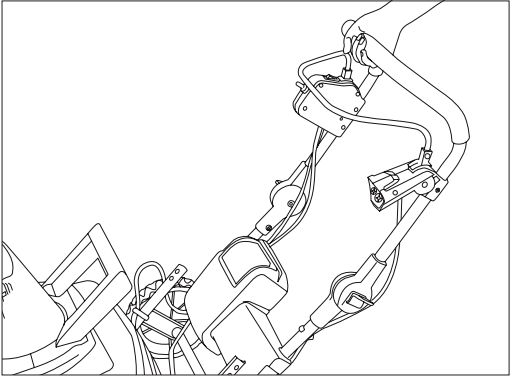
Secure the connection of the middle handle assembly to the upper handle by fastening the handle locks on each side.
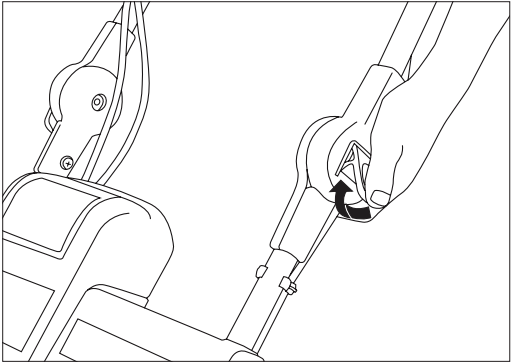
Secure the connection of the middle handle assembly to the lower handle using 2 handle knobs and 2 square J-bolts and tighten on each side.
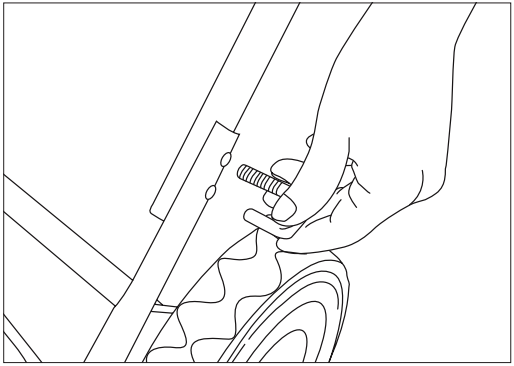
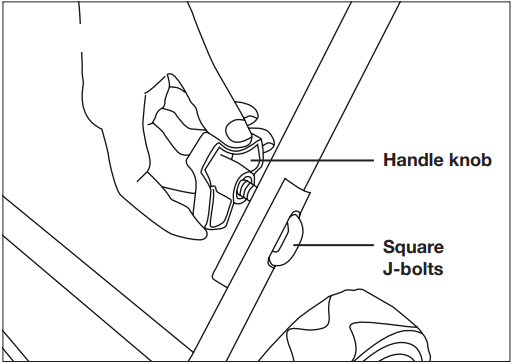
Discharge Chute Assembly
- Lift the chute deflector until it locks securely into place on the discharge chute.
- Raise or lower the chute deflector to the desired height of the snow stream.
Insert the washers into the middle of the chute connection, pass the carriage bolts through from the inside of the chute, and tighten with the deflector knobs on each side (Figs. 5 & 6).

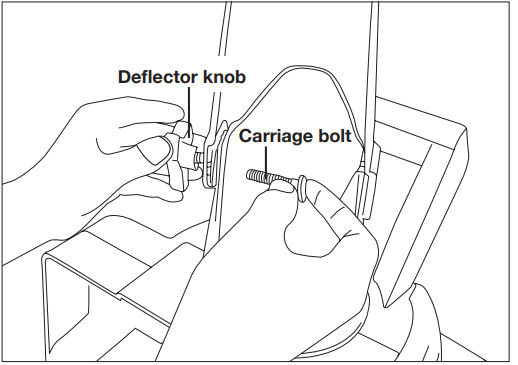
NOTE: Do not overtighten the knobs.
Battery Pack Operation
The equipment is powered by a lithium-ion battery. The battery pack is completely sealed and maintenance free.
Battery Charge Level Indicator
The battery pack is equipped with a push button for checking the charge level. Simply press the push button to read off the battery charge level from the LEDs of the battery indicator:
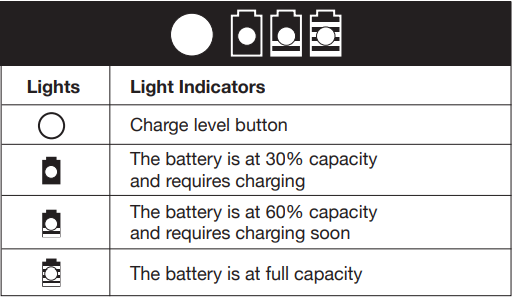
- All 3 level monitoring LEDs are lit: Battery charge level is high.
- 2 level monitoring LEDs are lit: Battery charge level is decreasing. Stop work as soon as possible.
- 1 level monitoring LED is lit: Battery is flat. Stop work IMMEDIATELY and charge the battery. Otherwise the battery’s service life will be greatly shortened.
NOTE: If the charge level button does not appear to be working, place the battery pack on the charger and charge as needed.
NOTE: Immediately after using the battery pack, the charge level button may display a lower charge than it will if checked a few minutes later. The battery cells “recover” some of their charge after resting.
Snow Joe Charger Operation
WARNING! Charge only iON MAX iBAT40 lithium-ion battery packs in compatible iON MAX iCHRG40 lithium-ion battery chargers. Other types of batteries may cause personal injury and damage. To reduce the risk of electric shock, do not allow water to flow into the charger's AC/DC plug.
Lithium-Ion Battery
NOTE: The iON MAX iBAT40 lithium-ion battery packs do not develop a "memory" when charged after only a partial discharge. Therefore, it is not necessary to run down the battery pack before placing it into the charger.
- Use the battery charge indicator lights to determine when to charge your iON MAX iBAT40 lithium-ion battery pack.
- You can "top-off" your battery pack's charge before starting a big job or after a long day of use.
Charging the Battery
Pull the push lock button on the battery to pull the battery pack up and out of the equipment.
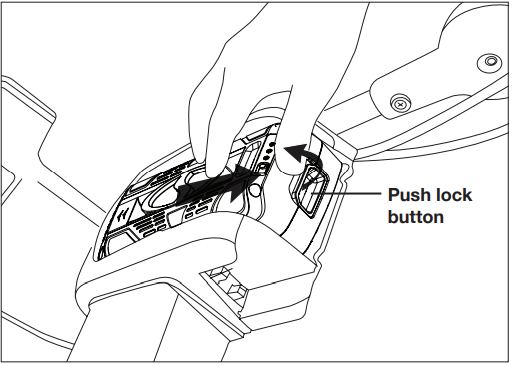
Check that the mains voltage is the same as that marked on the rating plate of the battery charger. Then, insert the charger's plug into the electrical wall outlet. When you plug in the charger, the top green light will illuminate and stay green.
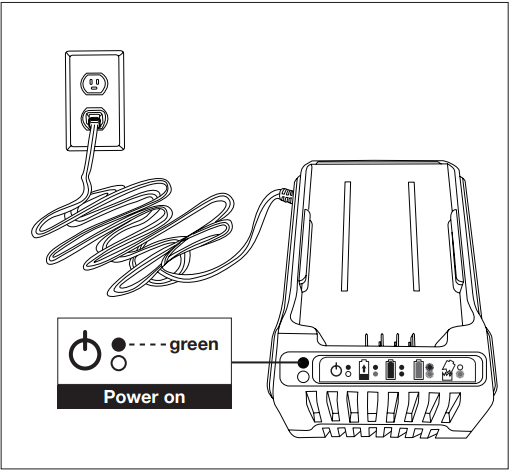
- Place the battery pack into the charger by sliding the pack as shown to lock it into position. When you insert the battery into the charger, the bottom red light will illuminate to indicate that the battery is charging.
When the bottom light turns green, the battery is fully charged.
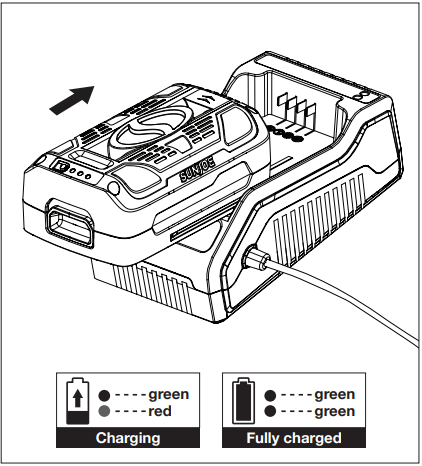
NOTE: If the top light remains green while the bottom light alternately flashes red and green, this indicates a temperature abnormality (i.e. that the battery pack is either too hot or too cold). If there is only a red blinking light, this indicates that something is wrong with the battery.

- A fully discharged pack with an internal temperature in the normal range will fully charge in 2.5 to 3 hours (between 32ºF/0ºC and 113ºF/45ºC). Heavily cycled battery packs may take longer to charge completely.
- If the charging light indicator alternately blinks red and green or the light indicator does not come on at all, check that the battery pack is fully seated into the bay. Remove the pack and reinsert.
When charging is complete, remove the battery from the charger by pulling the push lock button and sliding the battery backward to unlock it from the charger.
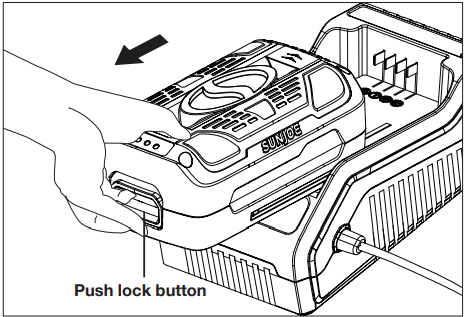
- Timely recharging of the battery will help prolong the battery's life. You must recharge the battery pack when you notice a drop in the equipment's power.
IMPORTANT! Never allow the battery pack to become fully discharged as this will cause irreversible damage to the battery.
Charging a Hot or Cold Battery Pack
A red and green flashing indicator light on the charger indicates that the battery pack temperature is outside the charging range. Once the pack is within the acceptable range, normal charging will take place and the red light will be continuous. Hot or cold battery packs may take longer to charge.
| Battery Pack Temperature | Red Charger Indicator Light | Charging Status |
|---|---|---|
| Too hot | Flashing | Not charging |
| Normal range | Continuous | Normal charging |
| Too cold | Flashing | Not charging |
Operation
WARNING! Keep the area to be cleared free of stones, toys or other foreign objects that the rotor blades might pick up and throw. Such items could be covered by snow are easy to overlook, so be sure to conduct a thorough inspection of the area before beginning work.
NOTE: Before using this machine, make sure that the snow blower’s roll shaft and rubber plates are firmly secured with screws, and that the rubber plates are facing the correct direction. Perform a test run to ensure that the rotor turns freely.
Starting the Machine
Open the battery compartment cover and slide the battery down until it clicks to lock it into position (Fig. 11).
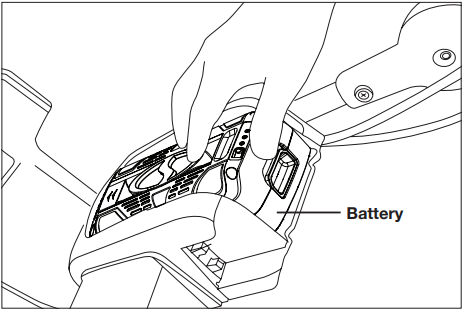
Insert the safety key into the slot and close the battery compartment cover (Figs. 12 & 13).
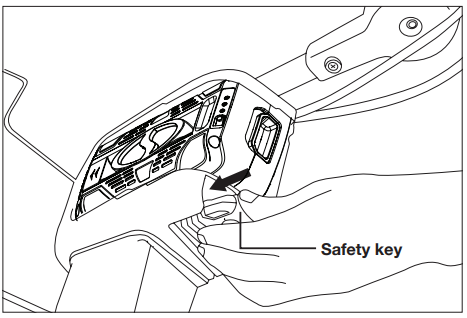
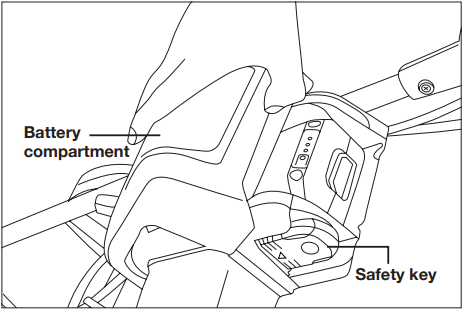
To start the cordless snow blower, first press the safety switch button found alongside the switch housing (Fig. 14).
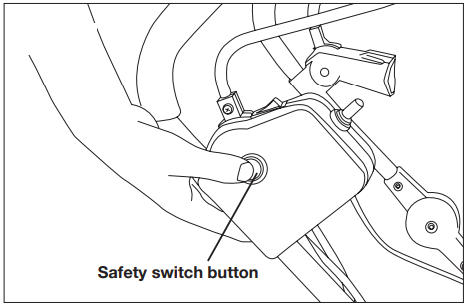
While depressing the safety switch button, pull the ON/OFF switch lever toward you. Once the machine powers on, release the safety switch button and begin operation (Fig. 15). The machine can only be started by depressing the safety switch button first, followed by squeezing the ON/OFF switch lever; reverse operation will not start the machine.
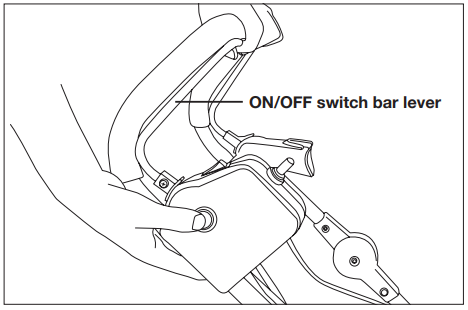
- To power off, release your grip on the ON/OFF switch bar lever.
Operating Tips
WARNING! Foreign objects, such as rocks, broken glass, nails, wire, or string, can be picked up and thrown by the snow blower, causing serious personal injury. Remove all foreign objects from the area to be plowed before operating the snow blower.
- Keep the area of operation free of foreign objects that can become thrown by the rotor blades. Perform a thorough inspection of the area since some objects may be hidden from view by surrounding snow. If the snow blower hits an obstruction or picks up a foreign object during use, stop the snow blower, remove the battery, remove the obstruction, and inspect the unit for damage. Repair or replace any damaged part before restarting and operating the unit.
- Keep children, pets, and bystanders away from the area of operation. Be aware that the normal noise of the machine when turned on may make it difficult for you to hear approaching people.
- When moving the snow blower, use the wheels on one side as the pivot point. Slightly tilt the snow blower on this pivot point to move it forward or backward.
- Start your clearing path outward, throwing snow in a back and forth motion. To clear in the opposite direction, pivot the snow blower on its wheels. Make sure to overlap clearing paths.
- Note the wind direction. If possible, move in the same direction as the wind so that the snow is not thrown against the wind (and thus back into your face and on the just cleared path).
- Do not push the snow blower with excessive force. You should push the machine gently and evenly in accordance with the unit’s throw rate.
- Do not apply additional man-made load to the motor since this may cause motor damage.
- Some parts of the snow blower may freeze under extreme temperature conditions. Do not attempt to operate the snow blower with frozen parts. If the parts freeze while the snow blower is in use, stop the snow blower, remove the battery, and inspect for frozen parts. Free all parts before restarting or operating the snow blower. Never force controls that have frozen.
- When working on pebbles, gravel, or unpaved surfaces, avoid throwing loose surface material along with the snow by pushing down on the handle to raise the scraper at the base of the unit above the pebbles or gravel.
To utilize the LED light for nighttime snow removal, activate the LED light switch located on the switch bar harness.
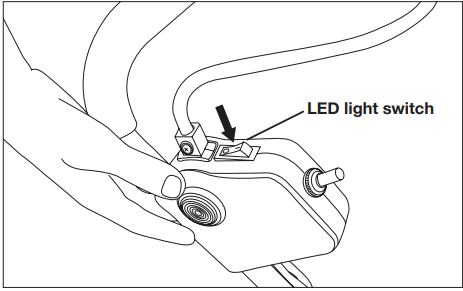
NOTE: After you have finished using your snow blower, remember to turn OFF the light switch.
The LED light can be adjusted by moving it up and down as depicted.
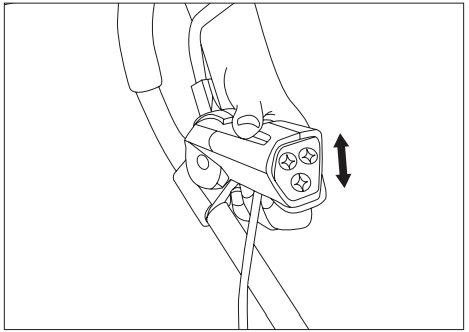
Changing Throw Direction + Throw Height
WARNING! Never direct the snow discharge chute at the operator, at bystanders, at vehicles, or at nearby windows. The discharged snow and foreign objects accidentally picked up and thrown by the snow blower can cause serious damage and personal injury.
Always orient the discharge chute in the opposite direction from where the operator, bystanders, surrounding vehicles, or windows are located.
The discharge chute can be controlled 180 degrees by rotating the chute with the remote switch (Fig. 18).

The chute deflector on the top of the discharge chute controls the height of the snow stream. Loosen the knobs to raise or lower the deflector to the desired height of snow you wish to throw. Tighten the knobs to secure the deflector (Fig. 19).
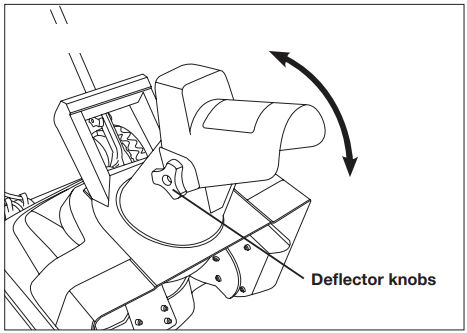
WARNING! Make sure that the chute deflector locks completely onto the discharge chute. An opening between the discharge chute and the chute deflector may allow foreign objects to be picked up by the snow blower and thrown in the direction of the operator causing serious bodily injury.
- Do not advance the chute deflector too far forward as this can cause an opening to appear between the deflector and discharge chute.
- Do not overtighten the knobs on the chute deflector (Fig. 19).
Maintenance of Snow Joe Cordless Snow Blower iON18SB
To order genuine replacement parts or accessories for the Snow Joe® iON18SB cordless snow blower, please visit snowjoe.com or contact the Snow Joe® + Sun Joe® customer service center at 1-866-SNOWJOE (1-866-766-9563).
WARNING! Make sure to turn off the switch and remove the battery before performing any maintenance task on your snow blower.
Lifetime Lubrication (Motor + Auger)
Lubrication is not necessary and may damage the unit. The snow blower is lubricated for lifetime use at the factory before shipment.
General Maintenance Tips
- Do not attempt to repair the machine unless you have the proper tools and instructions for disassembly and repair of the machine.
- Check bolts and screws at frequent intervals for proper tightness to ensure that the equipment is in safe working condition.
- After each snow removal session, run the snow blower for a few minutes to prevent the collector/impeller from freezing. Shut off the motor, wait for all revolving parts to stop completely, and wipe residual ice and snow off the unit. Rotate the chute deflector by the remote switch several times to remove any excess snow.
Proper Care for Battery + Charger
WARNING! To reduce the risk of injury, always unplug the charger and remove the battery pack from the charger before performing any maintenance task. Never disassemble the battery pack or charger.
- To reduce the risk of injury and damage, never immerse your battery pack or charger in liquid or allow any liquid to flow inside these components.
- Clean out dust and debris from charger vents and electrical contacts by blowing with compressed air.
- Use only mild soap on a damp cloth to clean the battery pack and charger, keeping away from all electrical contacts. Certain cleaning agents and solvents are harmful to plastics and other insulated parts. Some of these include gasoline, turpentine, lacquer thinner, paint thinner, chlorinated cleaning solvents, ammonia and household detergents containing ammonia. Never use flammable or combustible solvents around battery packs, battery chargers or tools.
- The iONMAX iCHRG40 lithium-ion battery charger has no serviceable parts.
Replacing the Rubber Plates
WARNING! Make sure to turn off the switch and remove the battery before performing any maintenance task on your cordless snow blower.
NOTE: When replacing worn rubber plates, pay close attention to the order in which you remove the plates. Insert the new plates in the reverse order.
Detach the worn rubber plate assembly by removing the 8 sets of nuts and bolts used to secure it.

Install the new rubber plate assembly by tightening the 8 sets of nuts and bolts on both sides.
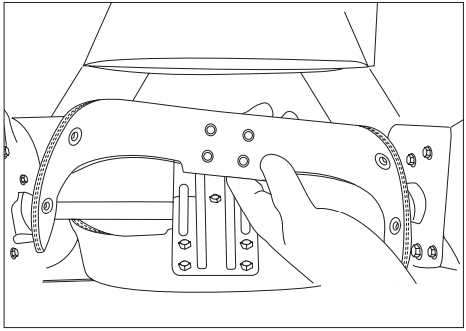
Replacing the Scraper Bar
The scraper bar is located at the base of the snow blower beneath the rotor housing.

Detach the worn scraper bar from the snow blower by removing the 4 screws that hold it in place.
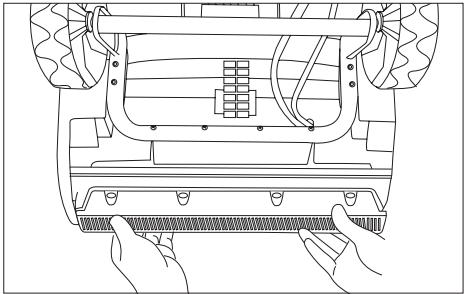
- Install the new scraper bar and fasten it securely to the snow blower with 4 screws.
Snow Joe Cordless Snow Description
The Snow Joe Cordless Snow Blower iON18SB is a powerful and eco-friendly solution for tackling snowy walkways, driveways, and other outdoor spaces. With a 40V iONMAX rechargeable battery system, this snow blower delivers consistent and reliable performance, with a clearing width of 18 inches and an intake height of 8 inches. The two-blade auger efficiently moves up to 400 lbs. of snow per minute, while the rubber-tipped steel augers ensure durability and safety. The easy-adjust chute control allows you to direct snow up to 20 feet away, and the LED headlight provides better visibility in low light conditions. Weighing only 32 lbs., this lightweight and compact snow blower is easy to maneuver and store, making it an ideal choice for homeowners and businesses alike.
Setup Guide
To operate the Snow Joe Cordless Snow Blower iON18SB, follow these steps
- Charge the battery fully before first use.
- Insert the battery into the battery compartment and make sure it clicks into place.
- Adjust the chute control to the desired direction.
- Push the quick-start button and pull the trigger to start the snow blower.
- Slowly guide the snow blower along the snow-covered surface, keeping a consistent pace and direction.
- After use, remove the battery and store it in a cool, dry place.
Snow Blower Troubleshooting
Here are some common problems and solutions for the Snow Joe Cordless Snow Blower iON18SB:
- Problem: The snow blower won't start.
Solution: Make sure the battery is fully charged and properly inserted. If the problem persists, contact Snow Joe customer support. - Problem: The snow blower is not moving snow.
Solution: Check the intake height and adjust if necessary. Make sure the snow blower is moving at a consistent pace and direction. If the problem persists, contact Snow Joe customer support.
Warranty
This Warranty is extended by Snow Joe® + Sun Joe® to the owner of this Machine (a “Machine” consists of a product powered by a motor) for residential and personal household use only. This Warranty does not apply to products used for commercial, rental or re-sale purposes. Should ownership of this machine change during the 2-year period, please update the Machine’s owner information at snowjoe.com/ProductRegistration.
Pros & Cons
Pros
- Cordless design for easy maneuverability
- Powerful and efficient snow clearing
- Easy-adjust chute control
- LED headlight for better visibility
- Compact and lightweight design
Cons
- Higher price point compared to some competitors
- Limited battery life (up to 50 minutes on a single charge)
Customer Reviews about Snow Blower iON18SB
Customers have praised the Snow Joe Cordless Snow Blower iON18SB for its powerful snow clearing capabilities, easy maneuverability, and compact design. However, some have criticized its limited battery life and higher price point compared to some competitors. Common complaints include difficulty with battery charging and issues with auger and chute assembly.
Faqs
How should the Snow Joe Cordless Snow Blower iON18SB be assembled?
How long does the Snow Joe Cordless Snow Blower iON18SB last? What kind of battery does it use?
How should I store the Snow Joe Cordless Snow Blower iON18SB when not in use?
What upkeep is necessary following use for the Snow Joe Cordless Snow Blower iON18SB?
What safety precautions should I follow when using the Snow Joe Cordless Snow Blower iON18SB?
For what kinds of surfaces is the Snow Joe iON18SB Cordless Snow Blower appropriate?
After usage, how should the Snow Joe Cordless Snow Blower iON18SB be cleaned and stored?
What is the best way to get my Snow Joe Cordless Snow Blower iON18SB ready for winter?
In order to extend the life of the Snow Joe Cordless Snow Blower iON18SB, how should it be stored?
Is there a warranty for the Snow Joe Cordless Snow Blower iON18SB?
Leave a Comment
